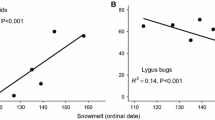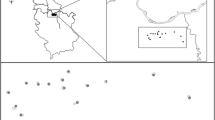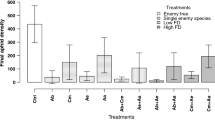Abstract
Drought threatens arthropod communities worldwide. Water limitation affects the quantity and quality of plants available to herbivores as food, and can also affect higher trophic-level consumers through variability in prey quality and reduced availability of suitable habitats. Our study assessed the response of an arthropod community to water limited wheat (Triticum aestivum L.) in a field setting. We used rainout shelters to exclude precipitation, irrigated raised bed plots to create three levels of water availability, and monitored arthropod community development over 8 weeks. First, we compared arthropod communities in habitats with different levels of water limitation and found that community composition was reliant on the magnitude of the water stress. This difference was largely due to the loss of piercing–sucking herbivores and predators in high-stress environments. Next, we focused on aphids and their natural enemies to investigate the underlying mechanisms driving community responses using structural equation modeling (SEM). Aphid abundance was negatively affected by water limitation, and this response was primarily associated with stress-induced plant physiological changes and not plant biomass or natural enemy abundance. Natural enemy abundance was also reduced in water-limited habitats, but natural enemies responded to plant biomass and not prey availability. These effects were exacerbated as water stress increased. The absence of natural enemy effects on aphids indicates that top–down predation effects were dampened by strong bottom–up effects of plant water limitation. This study revealed the importance of considering water stress intensity when predicting outcomes of droughts for arthropod communities.




Similar content being viewed by others
Data availability
The datasets generated during and/or analyzed during the current study are available from the corresponding author on reasonable request.
References
Ahmed SS, Liu D, Simon JC (2017) Impact of water-deficit stress on tritrophic interactions in a wheat-aphid-parasitoid system. PLoS ONE 12:1–17. https://doi.org/10.1371/journal.pone.0186599
Auclair JL (1963) Aphid feeding and nutrition. Annu Rev Entomol 8:439–490. https://doi.org/10.1146/annurev.en.08.010163.002255
Banfield-Zanin JA, Leather SR (2015) Drought intensity and frequency have contrasting effects on development time and survival of the green spruce aphid. Agric For Entomol 17:309–316. https://doi.org/10.1111/afe.12109
Barnett KL, Facey SL (2016) Grasslands, invertebrates, and precipitation: a review of the effects of climate change. Front Plant Sci 7:1–8. https://doi.org/10.3389/fpls.2016.01196
Barton BT, Ives AR (2014) Species interactions and a chain of indirect effects driven by reduced precipitation. Ecology 95:486–494. https://doi.org/10.1890/13-0044.1
Coumou D, Rahmstorf S (2012) A decade of weather extremes. Nat Clim Chang 2:491–496. https://doi.org/10.1038/nclimate1452
Denno RF, Gratton C, Peterson MA et al (2002) Bottom-up forces mediate natural-enemy impact in a phytophagous insect community. Ecology. https://doi.org/10.1890/0012-9658(2002)083[1443:BUFMNE]2.0.CO;2
Easterling DR, et al. (2017) Precipitation change in the United States In: Wuebbles DJ, Fahey DW, Hibbard KA, Dokken DJ, Stewart BC, Maycock TK (eds) Climate science special report: fourth national climate assessment, vol I. U.S. Global Change Research Program Washington, D.C., pp 207–230
Eigenbrode SD, Davis TS, Crowder DW, et al (2015) Climate change and biological control in agricultural systems: principles and examples from North America. Clim Chang Insect Pests: 119–135
Finke DL, Denno RF (2006) Spatial refuge from intraguild predation: Implications for prey suppression and trophic cascades. Oecologia 149:265–275. https://doi.org/10.1007/s00442-006-0443-y
Frampton GK, Van Den Brink PJ, Gould PJL (2000) Effects of spring drought and irrigation on farmland arthropods in southern Britain. J Appl Ecol 37:865–883. https://doi.org/10.1046/j.1365-2664.2000.00541.x
Gutbrodt B, Mody K, Dorn S (2011) Drought changes plant chemistry and causes contrasting responses in lepidopteran herbivores. Oikos 120:1732–1740. https://doi.org/10.1111/j.1600-0706.2011.19558.x
Hahn PG, Maron JL (2018) Plant water stress and previous herbivore damage affect insect performance. Ecol Entomol 43:47–54. https://doi.org/10.1111/een.12468
Hale BK, Bale JS, Pritchard J et al (2003) Effects of host plant drought stress on the performance of the bird cherry-oat aphid, Rhopalosiphum padi (L.): a mechanistic analysis. Ecol Entomol 28:666–677. https://doi.org/10.1111/j.1365-2311.2003.00563.x
Hassell MP, May RM (1986) Generalist and specialist natural enemies in insect predator-prey interactions. J Anim Ecol. https://doi.org/10.2307/4425
Huberty AF, Denno RF (2004) Plant water stress and its consequences for herbivorous insects: a new synthesis. Ecology 85:1383–1398. https://doi.org/10.1890/03-0352
Hunter MD, Price PW (1992) Playing chutes and ladders: heterogeneity and the relative roles of bottom-up and top-down forces in natural communities. Ecology 73:724–732. https://doi.org/10.2307/1940152
Johnson SN, Staley JT, McLeod FAL, Hartley SE (2011) Plant-mediated effects of soil invertebrates and summer drought on above-ground multitrophic interactions. J Ecol 99:57–65. https://doi.org/10.1111/j.1365-2745.2010.01748.x
Jones MS, Fu Z, Reganold JP, Karp DS, Besser TE, Tylianakis JM, Snyder WE (2019) Organic farming promotes biotic resistance to foodborne human pathogens. J Appl Ecol 56:1117–1127. https://doi.org/10.1111/1365-2664.13365
Kansman J, Nalam V, Nachappa P, Finke D (2020) Plant water stress intensity mediates aphid host choice and feeding behaviour. Ecol Entomol. https://doi.org/10.1111/een.12928
Knapp AK, Beier C, Briske DD et al (2008) Consequences of more extreme precipitation regimes for terrestrial ecosystems. Bioscience 58:811–821. https://doi.org/10.1641/B580908
Langellotto GA, Denno RF (2004) Responses of invertebrate natural enemies to complex-structured habitats: a meta-analytical synthesis. Oecologia 139:1–10. https://doi.org/10.1007/s00442-004-1497-3
Larsson S (1989) Stressful times for the plant stress: insect performance hypothesis. Oikos. https://doi.org/10.2307/3565348
Lee MA, Manning P, Walker CS, Power SA (2014) Plant and arthropod community sensitivity to rainfall manipulation but not nitrogen enrichment in a successional grassland ecosystem. Oecologia 176:1173–1185. https://doi.org/10.1007/s00442-014-3077-5
Lefcheck JS (2016) piecewiseSEM: piecewise structural equation modelling in r for ecology, evolution, and systematics. Methods Ecol Evol 7:573–579. https://doi.org/10.1111/2041-210X.12512
Lemoine R, La Camera S, Atanassova R et al (2013) Source-to-sink transport of sugar and regulation by environmental factors. Front Plant Sci 4:1–21. https://doi.org/10.3389/fpls.2013.00272
Mahmoud MAB, Sharp RE, Oliver MJ et al (2018) Response of maize hybrids with and without rootworm- and drought-Tolerance to rootworm infestation under well-watered and drought conditions. J Econ Entomol 111:193–208. https://doi.org/10.1093/jee/tox309
Martini X, Stelinski LL (2017) Drought stress affects response of phytopathogen vectors and their parasitoids to infection- and damage-induced plant volatile cues. Ecol Entomol 42:721–730. https://doi.org/10.1111/een.12439
McCluney KE, Belnap J, Collins SL et al (2012) Shifting species interactions in terrestrial dryland ecosystems under altered water availability and climate change. Biol Rev 87:563–582. https://doi.org/10.1111/j.1469-185X.2011.00209.x
McCune B, Mefford MJ (2011) PC-ORD Multivariate Analysis of Ecological Data
Mody K, Eichenberger D, Dorn S (2009) Stress magnitude matters: Different intensities of pulsed water stress produce non-monotonic resistance responses of host plants to insect herbivores. Ecol Entomol 34:133–143. https://doi.org/10.1111/j.1365-2311.2008.01053.x
Moreira X, Abdala-Roberts L, Parra-Tabla V, Mooney KA (2015) Latitudinal variation in herbivory: Influences of climatic drivers, herbivore identity and natural enemies. Oikos 124:1444–1452. https://doi.org/10.1111/oik.02040
Prein AF, Rasmussen RM, Ikeda K et al (2017) The future intensification of hourly precipitation extremes. Nat Clim Chang 7:48–52. https://doi.org/10.1038/nclimate3168
Rypstra AL, Carter PE, Balfour RA, Marshall SD (1999) Architectural features of agricultural habitats and their impact on the spider inhabitants. J Arachnol. https://doi.org/10.2307/3706009
Scheiner SM, Gurevitch J (2001) Design and analysis of ecological experiments. Oxford University Press
Sevanto S (2018) Drought impacts on phloem transport. Curr Opin Plant Biol 43:76–81. https://doi.org/10.1016/j.pbi.2018.01.002
Showler AT (2013) Plant-arthropod interactions affected by water deficit stress through association with changes in plant free amino acid accumulations. In: Molecular Approaches in Plant Abiotic Stress
Suttle KB, Thomsen MA, Power ME (2007) Species interactions reverse grassland responses to changing climate. Science 315:640–642. https://doi.org/10.1126/science.1136401
Taiz L, Zeiger E (2015) Plant Physiology (Sixth Edition)
Tariq M, Wright DJ, Rossiter JT, Staley JT (2012) Aphids in a changing world: testing the plant stress, plant vigour and pulsed stress hypotheses. Agric For Entomol 14:177–185. https://doi.org/10.1111/j.1461-9563.2011.00557.x
Tariq M, Wright DJ, Bruce TJA, Staley JT (2013) Drought and root herbivory interact to alter the response of above-ground parasitoids to aphid infested plants and associated plant volatile signals. PLoS ONE 8:1–12. https://doi.org/10.1371/journal.pone.0069013
Toft S (2005) The quality of aphids as food for generalist predators: implications for natural control of aphids. Eur J Entomol. https://doi.org/10.14411/eje.2005.054
Torode MD, Barnett KL, Facey SL et al (2016) Altered precipitation impacts on above-and below-ground grassland invertebrates: Summer drought leads to outbreaks in spring. Front Plant Sci 7:1–12. https://doi.org/10.3389/fpls.2016.01468
Trotter RT, Cobb NS, Whitham TG (2008) Arthropod community diversity and trophic structure: a comparison between extremes of plant stress. Ecol Entomol 33:1–11. https://doi.org/10.1111/j.1365-2311.2007.00941.x
Wade RN, Karley AJ, Johnson SN, Hartley SE (2017) Impact of predicted precipitation scenarios on multitrophic interactions. Funct Ecol 31:1647–1658. https://doi.org/10.1111/1365-2435.12858
Weldegergis BT, Zhu F, Poelman EH, Dicke M (2015) Drought stress affects plant metabolites and herbivore preference but not host location by its parasitoids. Oecologia 177:701–713. https://doi.org/10.1007/s00442-014-3129-x
Xie H, Shi J, Shi F et al (2020) Aphid fecundity and defenses in wheat exposed to a combination of heat and drought stress. J Exp Bot 71:2713–2722. https://doi.org/10.1093/jxb/eraa017
Zhu H, Wang D, Wang L et al (2014) Effects of altered precipitation on insect community composition and structure in a meadow steppe. Ecol Entomol 39:453–461. https://doi.org/10.1111/een.12120
Acknowledgements
We thank Bruce Hibbard, Felix Fritschi, and Abe Koo for contributing to the development of the research and providing comments on the manuscript. Additionally, we thank Bruce Hibbard for use of the rainout shelters, and Tim Praisewater, Mel Oliver, and Jim Elder for training and equipment use. We also thank Joe LaRose, Harper Smith, Katie LaPlante, Tanner Adkins, Kelsey Benthall, Kristin Tosie, and Mason Ward for their help preparing the field site, sampling, and processing data.
Funding
This project was supported by the University of Missouri Research Board and USDA NIFA MO-HAPS0006. Additionally, this work was supported by AFRI EWD (2019–67011-29729) from the USDA National Institute of Food and Agriculture.
Author information
Authors and Affiliations
Contributions
JK and DF formulated the study and designed experiments. JK performed experiments. DC provided assistance with statistical analysis. JK and DF wrote the manuscript with insight from DC.
Corresponding author
Ethics declarations
Conflict of interest
The authors declare that they have no conflict of interest.
Additional information
Communicated by Colin Mark Orians.
Plant water stress affects the whole community, but different trophic groups are responding to different bottom-up traits.
Supplementary Information
Below is the link to the electronic supplementary material.
Rights and permissions
About this article
Cite this article
Kansman, J.T., Crowder, D.W. & Finke, D.L. Primacy of plants in driving the response of arthropod communities to drought. Oecologia 195, 833–842 (2021). https://doi.org/10.1007/s00442-020-04844-0
Received:
Accepted:
Published:
Issue Date:
DOI: https://doi.org/10.1007/s00442-020-04844-0




